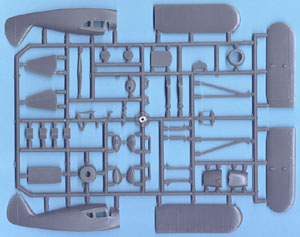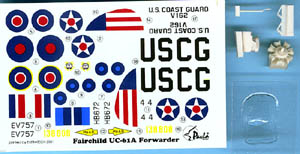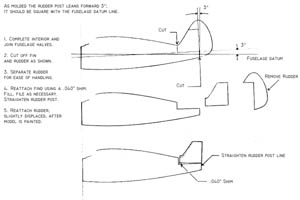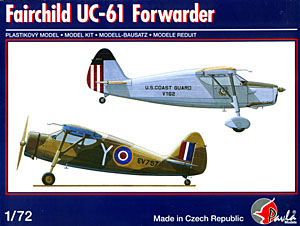Pavla 1/72 Fairchild F-24/UC-61 Forwarder/Argus | | History Sherman Fairchild (1896-1971) was a bright, indulged, child who grew up in a world of wealth and comfort. His father George's Tabulating Machine Company morphed into International Business Machines Company in 1911 and George became the first President and Chairman of the Board of that company, which is now IBM. Young Sherman was given free run, and use, of the company's shops, labs and offices to pursue his own interests and projects. He was interested in practically everything and had earned over 30 patents before he got into aviation. His first airplane was, in fact the one-off Sikorsky S.31 custom designed and built for him by Igor Sikorsky to fulfill a sale he had made, despite having no airplane to sell. During WWI Sherman developed the Fairchild Aerial Camera for the US Army. Post war, unable to sell his cameras, He set up Fairchild Aerial Surveys of Canada, Ltd. to make profitable use of them. The Fairchild Airplane Manufacturing Corporation was set up in 1925 to build airplanes purpose-designed for aerial survey work. These simple, reliable, capacious, airplanes were soon adapted to all manner of other uses and sold very well.  Model followed model until 1932 when the first model F-24C8 flew. It began a series of which ultimately 1,983 would be built by the time TEMCO's licensed production ended in Dallas in 1947. The F-24 series was always available with the buyer's choice of either a Warner Scarab seven cylinder air-cooled radial or Fairchild's own six-cylinder in-line air-cooled Ranger engine. The power available from these engines increased over the production life of the F-24 from 95HP in 1932 to 200HP in 1947. In 1940 the model designation system was changed from sequential letters following "F-24" to the format of, F-24W-40 or F-24R-40; the middle "W" or "R" indicating Warner or Ranger engine and the last dash number indicating the year of production - in this example - 1940. Along with the designation system change, 1940 saw changes to the engine cowling, fitment of a larger fin and much smaller, simpler, fairings on the main landing gear struts. Model followed model until 1932 when the first model F-24C8 flew. It began a series of which ultimately 1,983 would be built by the time TEMCO's licensed production ended in Dallas in 1947. The F-24 series was always available with the buyer's choice of either a Warner Scarab seven cylinder air-cooled radial or Fairchild's own six-cylinder in-line air-cooled Ranger engine. The power available from these engines increased over the production life of the F-24 from 95HP in 1932 to 200HP in 1947. In 1940 the model designation system was changed from sequential letters following "F-24" to the format of, F-24W-40 or F-24R-40; the middle "W" or "R" indicating Warner or Ranger engine and the last dash number indicating the year of production - in this example - 1940. Along with the designation system change, 1940 saw changes to the engine cowling, fitment of a larger fin and much smaller, simpler, fairings on the main landing gear struts.
In 1936 famed Industrial Designer Raymond Loewy conceived a very simple, very elegant, color pattern for the F-24s. Military models carried many designations, typically UC-61 and UC-86 for the Army and Air Force, GK-1 for the Navy, J2K-1 & -2 for the Coast Guard and Argus I, II and III for the RAF. In the US the F-24 was called "Forwarder". The entire F-24 series is much sought after by antique airplane enthusiasts. The Kit Within the lightweight end-opening box we find: 40 parts molded in medium gray styrene on one sprue tree; five very nice resin parts - a Warner Scarab engine, the first two cylinders of a Fairchild Ranger engine, two cabin entry steps and a pitot tube; one vac-formed windscreen; a small square of .025" clear stock; a beautiful decal sheet and an instructions folder.  The styrene parts are all well molded and sharply detailed with no sink marks. Parts are included to permit building either a Warner or Fairchild engined model with panted or open main wheels. As usual with limited run kits all joints are butt joints, which really ought to be reinforced with metal pins - I prefer Copper wire for this. You may remember the "Dumbbell Parts" from my review of Pavla's Curtiss 0-52 Owl in the June issue of this magazine; there are only three of them called for in this kit. That's a definite improvement over the Owl. The styrene parts are all well molded and sharply detailed with no sink marks. Parts are included to permit building either a Warner or Fairchild engined model with panted or open main wheels. As usual with limited run kits all joints are butt joints, which really ought to be reinforced with metal pins - I prefer Copper wire for this. You may remember the "Dumbbell Parts" from my review of Pavla's Curtiss 0-52 Owl in the June issue of this magazine; there are only three of them called for in this kit. That's a definite improvement over the Owl.
The decal sheet and painting guide provide for four military airplanes: A UC-61 (F-24W-41) of the USAAC in O.D. over gray; J2K-2, V162 (sic) of the US Coast Guard in overall Aluminum with chrome-yellow wing and tailplane tops; an Argus I (F-24W-41) of the RAF in Mid Stone and Dark Earth over Azure Blue and an Argus III (F-24R-41) of the Royal Army in overall Aluminum dope. Regarding the US Coast Guard bird: The markings in the kit are for a J2K-2 (F-24K) of 1939. The kit cannot be easily built into this model of F-24; the cowling is different, the landing gear strut fairings are different and the fin is much smaller and of a very different shape. In about 1977 retired Coast Guardian, Carlton W. Swickly, restored F-24R-46 (N81234) and painted it as J2K-2, V160. The kit markings thus do not replicate either the real J2K-2, V162 or Swickly's restoration as his plane bears USCG number V160. So, if you use the kit's USCG decals, you'll have to enter your model in the "Fantasy" class at your club's next contest. That, or you'll have to change the side number from V162 to V160. Am I picking nits again? Personally, I much prefer civilian Forwarders in the elegant Loewy designed paint pattern. I find two problems with this kit; one minor and one major. The minor one relates to the side windows. The instructions would have you cut the windows from the clear stock provided and press-fit/glue them into the window openings. This approach is fiddly and subject to all manner of pitfalls. As an alternative consider this: The F-24s all had wind-down windows in the doors - leave them open. Et Voila, half the problem is solved! After you've painted the cabin interior, but before detailing it and before joining the fuselage halves, apply clear Scotch, or equivalent, tape over the rear window openings on the outside. Firmly burnish the tape down without poking a hole in it. Place a drop of Future floor wax in the inside of each window opening onto the sticky side of the tape. Slosh it around to get it into all the corners. Vigorously tap out the excess wax and let dry overnight. Trim the excess tape to within 1mm of the window opening. Use a fresh blade for this and don't slip! When painting the exterior of the plane mask the rear windows with a liquid mask for damage-free ease of  removal. If you don't apply the wax to the sticky side of the tape you will find that over the years every dust mote, piece of dirt, sanding dust, etc. inside the model will wind up stuck to the inside of the windows and after about 20 years the tape will dry out and fall off. If the tape is fully sealed it will last at least 35 years - that's the oldest example that I have in my collection and I believe it will last longer than I will. Thanks to Charlie Schaaf for putting me onto this idea. removal. If you don't apply the wax to the sticky side of the tape you will find that over the years every dust mote, piece of dirt, sanding dust, etc. inside the model will wind up stuck to the inside of the windows and after about 20 years the tape will dry out and fall off. If the tape is fully sealed it will last at least 35 years - that's the oldest example that I have in my collection and I believe it will last longer than I will. Thanks to Charlie Schaaf for putting me onto this idea. The kit's major problem is far more serious. The rudder post is leaning forward a very noticeable three degrees from the vertical. I've included a drawing showing how to correct this error. One problem you won't have with this kit comes from the fact the F-24s had internal control locks for the ailerons and elevator, so you don't have to droop the elevator for accuracy. You might, however, wish to displace the rudder slightly for added interest. Conclusion A very well executed kit of a very pretty little airplane. It's been a favorite of mine since I built a solid balsa model of a Ranger powered F-24 back about 1939. With the tail problem corrected you'll have a great looking model. I do have a beef with kit manufacturers choosing military markings for subjects that are best known in their civil roles. Fortunately that's easily taken care of by any modeler of reasonable skill. Kudos to Pavla for another interesting and well executed subject that Tamegawagram will never touch. References You only need one reference for any Fairchild airplane... Fairchild Aircraft 1926-1987: Kent A. Mitchell, Narkiewicz/Thompson Publishing, Santa Ana, CA, 1997, ISBN 0-913322-04-0 | 


 




|
